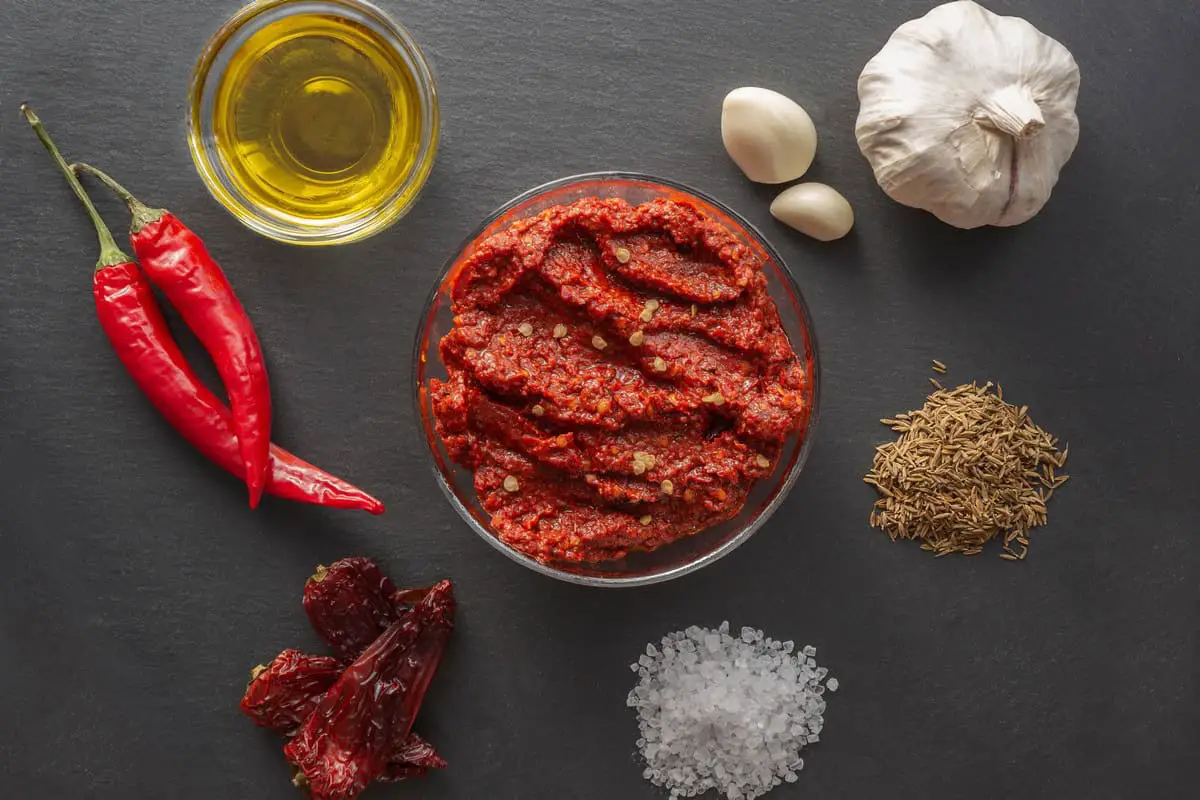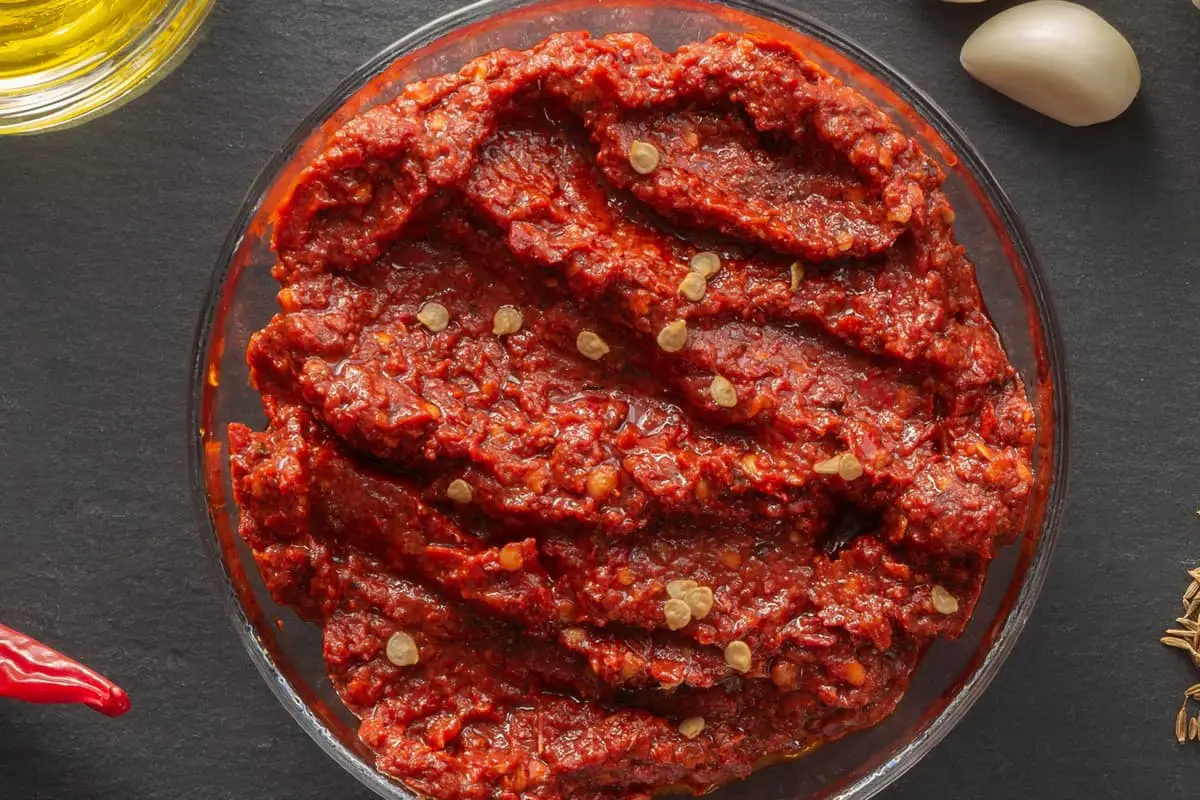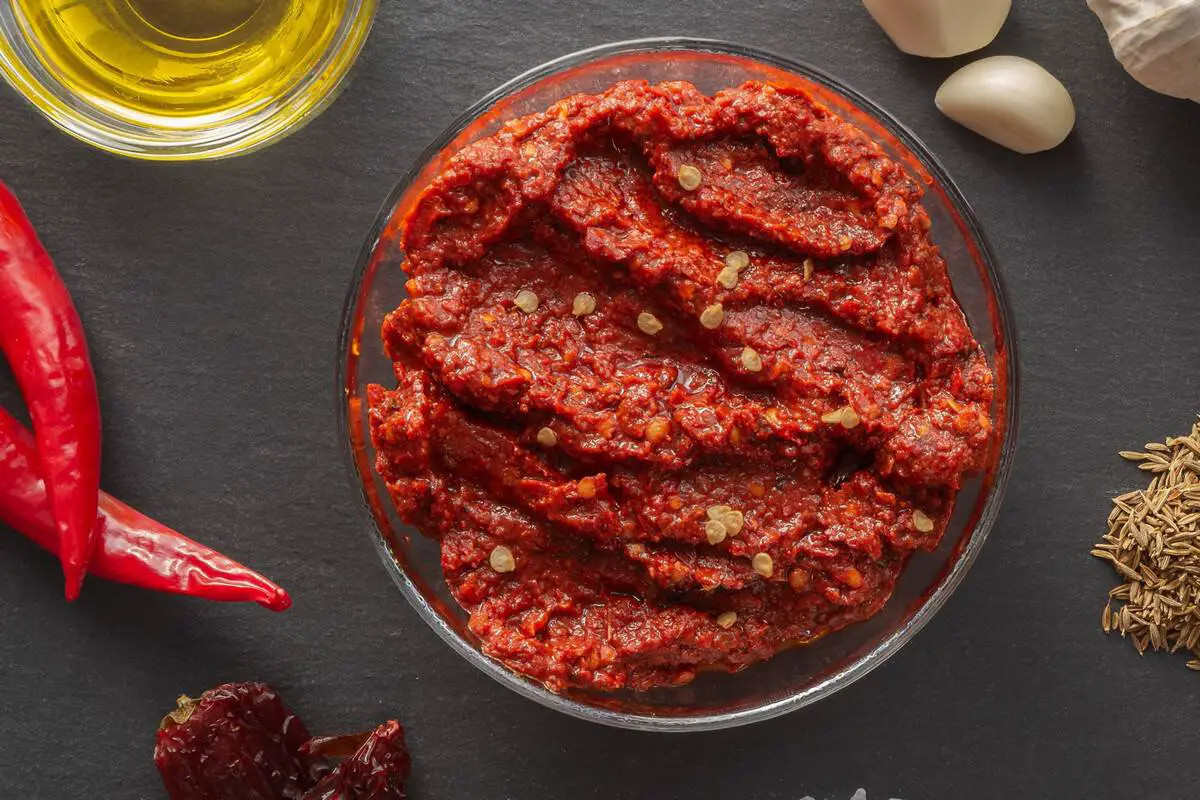
The Tunisian Harissa Recipe is a traditional North African dish known for its spicy and flavorful taste. It’s a staple in Tunisian cuisine and is often used as a condiment or ingredient in various dishes. This recipe has been passed down through generations and holds cultural significance in the region.
Want more ideas to round-out your Recipe Box from Africa?
A lot of great options are in these posts!
11 Tunisian Recipes For Your Kitchens
Tunisian Harissa Recipe offers potential health benefits due to its key ingredients. These ingredients include chili peppers, garlic, and olive oil. Chili peppers contain capsaicin, a compound that may have metabolism-boosting and pain-relieving properties. Garlic is known for its potential to support heart health and boost the immune system. Olive oil, a common base for the recipe, is rich in monounsaturated fats and antioxidants, which can contribute to overall well-being.
You May Want to Join The World Recipes With Our Big Escape
Share your own recipes in our Facebook Group. Find recipes from all over the world. Learn more about International Cuisine and how you can surprise your family with new and exciting foods from all over the world.
For More Photos Visit Our Instagram at World Recipes Daily
The combination of these ingredients in the Tunisian Harissa Recipe creates a bold and flavorful sauce with potential healthful effects. It’s used to enhance the taste of various dishes, from stews to grilled meats, and can add a kick to any meal. While its precise origins may vary in history, its popularity and reputation as a versatile and spicy condiment remain constant in Tunisian cuisine.

How To Make Our Tunisian Harissa Recipe
Ingredients (8 Servings)
1/2 cup extra-virgin olive oil
1 6-oz can tomato paste
12 oz red pepper flakes
16 dried red chilies
9 oz water *again, use the tomato paste can to measure (1 1/2 cans of water)
1 tbsp kosher salt
1 tsp cumin powder
1 tsp caraway powder
1/4 teaspoon caraway seeds
1 teaspoon coriander seeds
4 garlic cloves peeled
1 tbsp vinegar
2 tablespoons freshly squeezed lemon juice
1/4 cup olive oil to finish
Instructions
1. Prepping the Ingredients:
a. Gather all the required ingredients according to the provided list.
b. Measure 1/2 cup of extra-virgin olive oil.
c. Open a 6-oz can of tomato paste.
d. Measure 12 oz of red pepper flakes.
e. Take 16 dried red chilies.
f. Measure 9 oz of water using the tomato paste can (1 1/2 cans of water).
g. Measure 1 tbsp of kosher salt.
h. Measure 1 tsp of cumin powder.
i. Measure 1 tsp of caraway powder.
j. Measure 1/4 teaspoon of caraway seeds.
k. Measure 1 teaspoon of coriander seeds.
l. Peel 4 garlic cloves.
m. Measure 1 tbsp of vinegar.
n. Squeeze enough lemons to obtain 2 tablespoons of freshly squeezed lemon juice.
o. Measure 1/4 cup of olive oil to finish the harissa.
2. Blending the Base:
a. In a food processor, combine the tomato paste, red pepper flakes, dried red chilies, and water.
b. Blend until the mixture is smooth and well combined.
c. Add the kosher salt, cumin powder, caraway powder, caraway seeds, and coriander seeds.
d. Blend again until the spices are fully incorporated into the mixture.
3. Adding Flavor and Aroma:
a. Add the peeled garlic cloves, vinegar, and freshly squeezed lemon juice to the mixture.
b. Blend once more until the garlic is thoroughly combined and the mixture has a balanced flavor.
4. Adjusting the Consistency:
a. While blending, slowly pour in the extra-virgin olive oil to achieve a smooth and slightly thick consistency.
b. Continue blending until the olive oil is fully incorporated, and the harissa has a uniform texture.
5. Tasting and Finalizing:
a. Pause and taste the harissa to check for seasoning and spiciness. Adjust salt and lemon juice if necessary.
b. If the harissa is too thick, you can add a bit more olive oil and blend briefly to reach the desired texture.
Estimated Prep Time: 20 minutes
Estimated Cooking Time: N/A (No cooking involved in this recipe)

Pots, Pan and Cooking Equipment Needed forthe Tunisian Harissa Recipe
Food processor
Blender or mortar and pestle
Measuring cups and spoons
Mixing bowl
Storage containers for leftovers
Best Way to Store Leftovers From Tunisian Harissa Recipe
Store leftovers in airtight containers.
Use glass or plastic containers with tight-fitting lids.
Alternatively, use resealable plastic bags for smaller portions.
Label containers with the date to keep track of freshness.
Store in the refrigerator for up to 1 week.
Tips and Tricks For Easier Creation
Soak dried chilies in warm water to soften before blending.
Wear gloves while handling hot chili peppers to avoid irritation.
Adjust spice level by adding more or fewer dried chilies.
Toast caraway and coriander seeds for enhanced flavor.
Gradually add olive oil while blending for a smooth texture.
Experiment with different vinegar types for a unique taste.
Side Dishes and Desserts Forthe Tunisian Harissa Recipe
Grilled chicken or lamb skewers
Roasted vegetables like carrots and bell peppers
Couscous or quinoa for a hearty base
Fresh pita bread or naan for dipping
Greek yogurt with cucumber and mint
Hummus with assorted crudites
Rice pilaf with chopped nuts and dried fruits
How To Serve the Cuban Tunisian Harissa Recipe</h4
Serve the harissa as a condiment for grilled meats.
Use it as a dipping sauce for bread or vegetables.
Mix a spoonful into soups or stews for added flavor.
Drizzle over roasted vegetables or couscous.
Offer it alongside various appetizers at gatherings.
Store any unused harissa in the refrigerator.
Dietary Substitution For the Tunisian Harissa Recipe
1. Vegan Options for the Tunisian Harissa Recipe:
a. Substitute 1/4 cup of tahini for the 1/4 cup of olive oil to finish.
b. Replace honey with agave nectar as a vegan-friendly sweetener.
c. Use tamari instead of regular soy sauce for added umami without animal products.
d. Opt for nutritional yeast to enhance the savory flavor without using cheese.
e. Replace Worcestershire sauce with a vegan-friendly alternative for depth of flavor.
2. Gluten-Free Options for the Tunisian Harissa Recipe:
a. Use gluten-free tamari instead of regular soy sauce.
b. Choose a gluten-free vinegar such as apple cider vinegar.
c. Ensure the tomato paste and red pepper flakes are gluten-free certified.
d. Select a gluten-free cumin powder to avoid cross-contamination.
e. Use a gluten-free lemon juice if needed.
3. Vegetarian Options for the Tunisian Harissa Recipe:
a. Keep the recipe as is; it’s already vegetarian-friendly.
4. Mediterranean Diet Options for the Tunisian Harissa Recipe:
a. Keep the recipe as is; it aligns well with the Mediterranean diet’s focus on olive oil, herbs, and spices.
b. Choose whole-grain pita bread for serving.
5. Keto Diet Options for the Tunisian Harissa Recipe:
a. Reduce the amount of tomato paste to lower carb content.
b. Use erythritol or stevia as a sugar substitute for a keto-friendly sweetener.
c. Limit the amount of red pepper flakes for reduced carb intake.
d. Adjust the serving size to fit within daily carb limits.
e. Serve with keto-friendly vegetables like cauliflower or zucchini.
6. Heart Healthy Diet Options for the Tunisian Harissa Recipe:
a. Use extra-virgin olive oil for its heart-healthy monounsaturated fats.
b. Choose a low-sodium soy sauce or tamari to reduce sodium content.
c. Opt for freshly squeezed lemon juice without added sugar.
d. Use a salt substitute or reduce the amount of kosher salt.
e. Select a vinegar with no added sugar.
7. Paleo Options for the Tunisian Harissa Recipe:
a. Replace soy sauce with coconut aminos to avoid soy.
b. Choose a paleo-friendly sweetener like honey or maple syrup.
c. Use almond flour instead of wheat-based flours for thickening if needed.
d. Select a paleo-compliant vinegar like apple cider vinegar.
e. Ensure all ingredients are free from grains, legumes, and dairy.
8. Low Carb Options for the Tunisian Harissa Recipe:
a. Limit the amount of tomato paste to lower carb content.
b. Use erythritol or stevia as a sugar substitute for a low-carb sweetener.
c. Choose a low-carb vinegar such as apple cider vinegar.
d. Opt for a low-carb citrus juice if desired.
e. Serve with low-carb vegetables like broccoli or asparagus.
9. Whole30 Options for the Tunisian Harissa Recipe:
a. Choose a Whole30-compliant vinegar and lemon juice.
b. Use coconut aminos instead of soy sauce.
c. Opt for a Whole30-approved sweetener like dates or compliant fruit.
d. Check labels to ensure all ingredients are free from additives and sugars.
e. Serve with Whole30-approved vegetables and proteins.
10. Weight Watchers Options for the Tunisian Harissa Recipe:
a. Choose lean protein sources for serving, such as skinless chicken or turkey.
b. Adjust serving sizes to fit within your Weight Watchers points.
c. Opt for zero-point foods like vegetables for dipping.
d. Use non-caloric sweeteners if needed for a lower point count.
e. Consider using low-point oils for blending.
11. Low Fat Options for the Tunisian Harissa Recipe:
a. Reduce the amount of olive oil for a lower fat content.
b. Use low-fat versions of condiments like vinegar and lemon juice.
c. Limit the amount of nuts and seeds for garnish.
d. Opt for lean protein sources for serving.
e. Choose a lower fat variety of tomato paste.
12. Vegetable Variations for the Tunisian Harissa Recipe:
a. Add roasted red bell peppers for additional depth of flavor.
b. Use carrot juice in place of water for natural sweetness.
c. Blend in roasted garlic for a richer taste.
d. Incorporate sun-dried tomatoes for a concentrated tangy flavor.
e. Include sautéed onions for a savory twist.
It’s always recommended to check labels, choose quality ingredients, and consult with a healthcare professional or registered dietitian for personalized advice.

FAQ About the Tunisian Harissa Recipe
What is the Tunisian Harissa Recipe?
The Tunisian Harissa Recipe is a traditional North African spicy condiment made with ingredients such as red pepper flakes, dried red chilies, garlic, olive oil, and various spices. It’s known for its bold flavor and versatility in enhancing dishes.
How do I store leftovers of the Tunisian Harissa Recipe?
To store leftovers of the Tunisian Harissa Recipe, transfer it to airtight containers and refrigerate. Use glass or plastic containers with tight-fitting lids. Label the containers with the date for freshness tracking. Leftovers can be stored in the refrigerator for up to 1 week.
Can I make the Tunisian Harissa Recipe vegan-friendly?
Yes, you can make the Tunisian Harissa Recipe vegan-friendly. Substitute 1/4 cup of tahini for the 1/4 cup of olive oil to finish. Also, ensure that any condiments used, like soy sauce or Worcestershire sauce, are vegan-approved versions.
Are there gluten-free options for the Tunisian Harissa Recipe?
Yes, you can make gluten-free versions of the Tunisian Harissa Recipe. Use gluten-free tamari or soy sauce, choose a gluten-free vinegar, and ensure that ingredients like tomato paste and red pepper flakes are certified gluten-free.
How can I adapt the Tunisian Harissa Recipe for a keto diet?
To adapt the Tunisian Harissa Recipe for a keto diet, reduce the amount of tomato paste for lower carb content. Use a keto-friendly sweetener like erythritol or stevia. Limit the quantity of red pepper flakes and adjust serving sizes to fit within daily carb limits. Serve with keto-friendly vegetables or proteins.
Final Thoughts
The Tunisian Harissa Recipe is a traditional North African condiment, renowned for its fiery flavor and adaptability. Crafted from red pepper flakes, dried chilies, garlic, olive oil, and a medley of spices, this recipe offers a robust culinary experience. Its rich history and cultural significance make it a cherished component of Tunisian cuisine.
With potential health benefits stemming from ingredients like garlic and olive oil, the Tunisian Harissa Recipe provides both zest and nourishment. It can be stored, shared, and savored in various dishes, enhancing the taste buds and adding a touch of North African tradition to meals.
Tunisian Harissa Recipe
Ingredients
Equipment
Method
- a. Gather all the required ingredients according to the provided list.
- b. Measure 1/2 cup of extra-virgin olive oil.
- c. Open a 6-oz can of tomato paste.
- d. Measure 12 oz of red pepper flakes.
- e. Take 16 dried red chilies.
- f. Measure 9 oz of water using the tomato paste can (1 1/2 cans of water).
- g. Measure 1 tbsp of kosher salt.
- h. Measure 1 tsp of cumin powder.
- i. Measure 1 tsp of caraway powder.
- j. Measure 1/4 teaspoon of caraway seeds.
- k. Measure 1 teaspoon of coriander seeds.
- l. Peel 4 garlic cloves.
- m. Measure 1 tbsp of vinegar.
- n. Squeeze enough lemons to obtain 2 tablespoons of freshly squeezed lemon juice.
- o. Measure 1/4 cup of olive oil to finish the harissa.
- a. In a food processor, combine the tomato paste, red pepper flakes, dried red chilies, and water.
- b. Blend until the mixture is smooth and well combined.
- c. Add the kosher salt, cumin powder, caraway powder, caraway seeds, and coriander seeds.
- d. Blend again until the spices are fully incorporated into the mixture.
- a. Add the peeled garlic cloves, vinegar, and freshly squeezed lemon juice to the mixture.
- b. Blend once more until the garlic is thoroughly combined and the mixture has a balanced flavor.
- a. While blending, slowly pour in the extra-virgin olive oil to achieve a smooth and slightly thick consistency.
- b. Continue blending until the olive oil is fully incorporated, and the harissa has a uniform texture.
- a. Pause and taste the harissa to check for seasoning and spiciness. Adjust salt and lemon juice if necessary.
- b. If the harissa is too thick, you can add a bit more olive oil and blend briefly to reach the desired texture.
Notes


